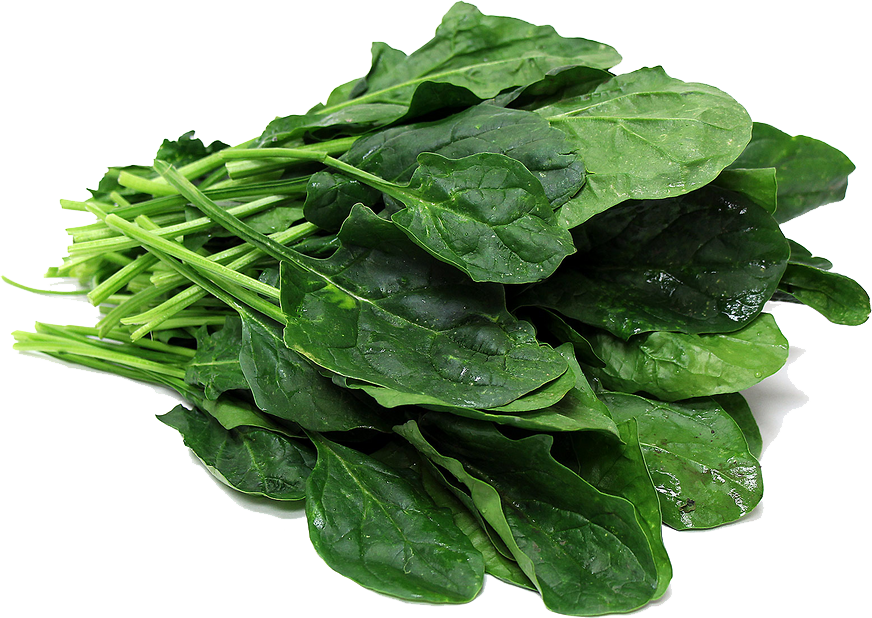
This image has format transparent PNG with resolution 872x618.
You can download this image in best resolution from this page and use it for design and web design.
Spinach PNG with transparent background you can download for free, just click on download button.
Spinach (Spinacia oleracea) is a leafy green flowering plant native to central and western Asia. It is of the order Caryophyllales, family Amaranthaceae, subfamily Chenopodioideae. Its leaves are a common edible vegetable consumed either fresh, or after storage using preservation techniques by canning, freezing, or dehydration. It may be eaten cooked or raw, and the taste differs considerably; the high oxalate content may be reduced by steaming.
It is an annual plant (rarely biennial), growing as tall as 30 cm (1 ft). Spinach may overwinter in temperate regions. The leaves are alternate, simple, ovate to triangular, and very variable in size: 2–30 cm (1–12 in) long and 1–15 cm (0.4–5.9 in) broad, with larger leaves at the base of the plant and small leaves higher on the flowering stem. The flowers are inconspicuous, yellow-green, 3–4 mm (0.1–0.2 in) in diameter, and mature into a small, hard, dry, lumpy fruit cluster 5–10 mm (0.2–0.4 in) across containing several seeds.
In 2017, world production of spinach was 27.9 million tonnes, with China alone accounting for 92% of the total.
The English word "spinach" dates to the late 14th century from espinache (French, épinard) of uncertain origin.
Common spinach, S. oleracea, was long considered to be in the family Chenopodiaceae, but in 2003 that family was merged into the Amaranthaceae in the order Caryophyllales. Within the family Amaranthaceae sensu lato, Spinach belongs to the subfamily Chenopodioideae.
Spinach is an annual plant (rarely biennial) growing as tall as 30 cm (1 ft). Spinach may overwinter in temperate regions. The leaves are alternate, simple, ovate to triangular, and very variable in size: 2–30 cm (1–12 in) long and 1–15 cm (0.4–5.9 in) broad, with larger leaves at the base of the plant and small leaves higher on the flowering stem. The flowers are inconspicuous, yellow-green, 3–4 mm (0.1–0.2 in) in diameter, and mature into a small, hard, dry, lumpy fruit cluster 5–10 mm (0.2–0.4 in) across containing several seeds.
In 2017, world production of spinach was 27.9 million tonnes, with China alone accounting for 92% of the total.
Fresh spinach is sold loose, bunched, or packaged fresh in bags. Fresh spinach loses much of its nutritional value with storage of more than a few days. Fresh spinach is packaged in air, or in nitrogen gas to extend shelf life. While refrigeration slows this effect to about eight days, fresh spinach loses most of its folate and carotenoid content over this period of time. For longer storage, it is canned, or blanched or cooked and frozen. Frozen spinach can be stored for up to eight months.
Some packaged spinach is exposed to radiation to kill any harmful bacteria. The Food and Drug Administration approves of irradiation of spinach leaves up to 4.0 kilograys; however, using radiation to sanitize spinach is of concern because it may deplete the leaves of their nutritional value.
Researchers at the Agricultural Research Service experimentally tested the concentrations of vitamins C, E, K, B9, and four carotenoids in packaged spinach following irradiation. They found with increasing level of irradiation, four nutrients showed little or no change. Those nutrients include vitamins B9, E, K, and the carotenoid neoxanthin. This study showed the irradiation of packaged spinach to have little or no change to the nutritional value of the crop, and the health benefits of irradiating packed spinach to reduce harmful bacteria seem to outweigh the loss of nutrients.
Spinach may be high in cadmium contamination depending on the soil and location where the spinach is grown
In this clipart you can download free PNG images: Spinach PNG images free download